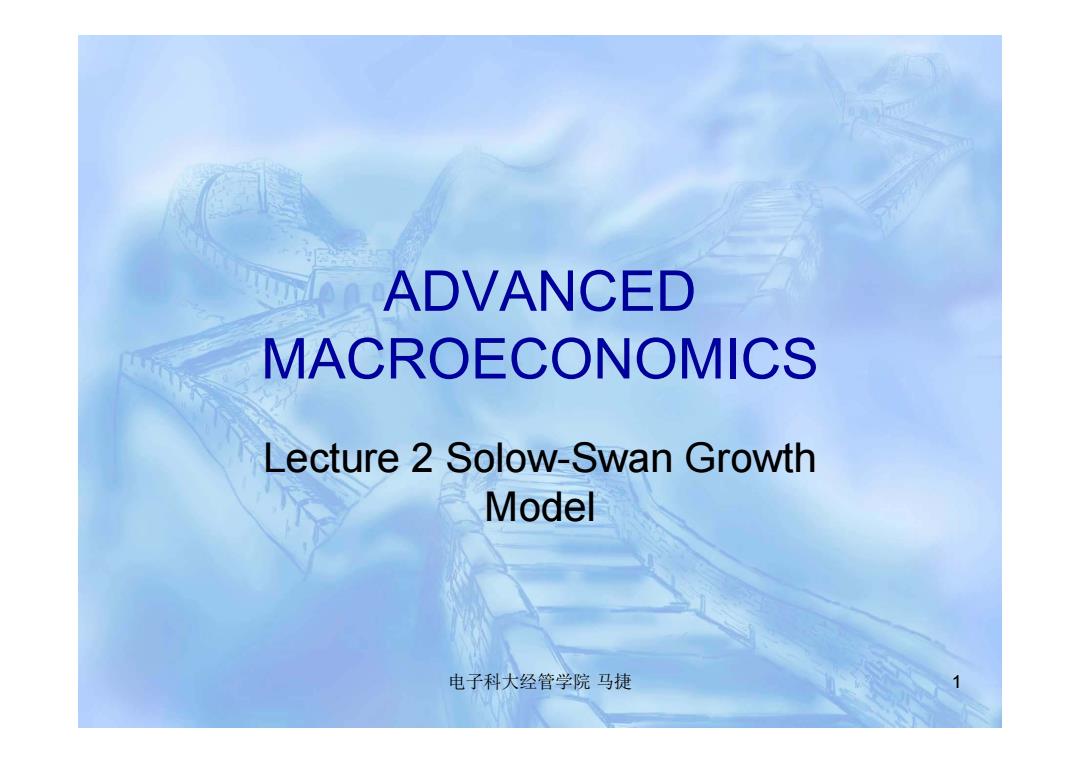
ADVANCED MACROECONOMICS Lecture 2 Solow-Swan Growth Model 电子科大经管学院马捷
ADVANCED MACROECONOMICS Lecture 2 Solow-Swan Growth Model 电子科大经管学院 马捷 1

Contents ·Introduction Mathematical Framework Graphical Representation Empirical Evidence Criticisms References 电子科大经管学院马捷 2
Contents Introduction Mathematical Framework Graphical Representation Empirical Evidence Criticisms References 电子科大经管学院 马捷 2

Introduction Developed by Robert Solow in 1956 -Extension to the Harrod-Domar model: Adding labor as a factor of production; The capital-output and capital-labor ratios are not fixed Requiring diminishing returns to labor and capital separately,and constant returns to scale for both factors combined; Introducing a time-varying technology variable distinct from capital and labor. 电子科大经管学院马捷 3
Introduction Developed by Robert Solow in 1956. Extension to the Harrod-Domar model: • Adding labor as a factor of production; • The capital-output and capital-labor ratios are not fixed • Requiring diminishing returns to labor and capital separately, and constant returns to scale for both factors combined; • Introducing a time-varying technology variable distinct from capital and labor. 电子科大经管学院 马捷 3

Five Macroeconomic Equations 0 The production function:Y:=AF(K:,L) F is stationary,continuous and twice differentiable. GDP equation Y=C+G+C+lsY Savings function:/=sY Change in capital::△KsYrδK Change in workforce:L=Lt.1(1+n)=(1+n)Lo 电子科大经管学院马捷
Five Macroeconomic Equations The production function: Yt = A t F ( Kt, L t) F is stationary, continuous and twice differentiable. GDP equation : Yt = C t + G t + I t C t + I t ≤ Yt Savings function: I t =sYt Change in capital: ∆ Kt =sYt - Kt Change in workforce: L t = L t-1(1+ n)=(1+ n ) t L 0 电子科大经管学院 马捷 4

“Neoclassical”Properties 1.F(K,L)=F(K,L),4>0. 2.Fx(K,L)>0,F(K,L)>0,F(K,L)>0, F(K,L)<0,Fu(K,L)<0 3.lim F =limF=0o, K)0 L-→0 lim Fk lim F =0. K->oc L00 Implication:F(0,L)=F(K,0)=0, F(K,L)=Fk(K,L)K+F(K,L)L or 1=8k+8L 电子科大经管学院马捷 5 元元元
“Neoclassical” Properties K L K L L L K K L L K K KK LL K L KL F K L F K L K F K L L or F F F F F K L F K L F K L F K L F K L F K L F K L ( , ) ( , ) ( , ) 1 Implication : F (0,L) F (K, 0) 0, lim lim 0. 3. lim lim , ( , ) 0, ( , ) 0. 2. ( , ) 0, ( , ) 0, ( , ) 0, 1. ( , ) ( , ), 0. 0 0 电子科大经管学院 马捷 5